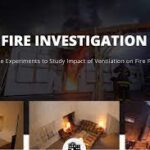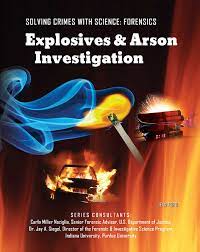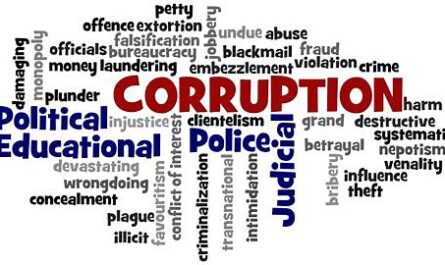Introduction:
Arson, the deliberate act of setting fire to property or structures, poses significant risks to public safety, property, and the environment. Arson investigation, the process of determining the cause and origin of fires, plays a crucial role in identifying perpetrators, preventing future incidents, and ensuring justice for victims. This essay examines the phenomenon of arson in the United States, explores common techniques used in arson investigation, and discusses challenges and advancements in the field.

Understanding Arson
Definition and Types:
Arson is defined as the intentional act of setting fire to property or structures. It encompasses various types, including structural arson (fires set to buildings), vehicle arson (fires set to vehicles), and wildland arson (fires set to forests or grasslands).
Motives:
Arson can be motivated by various factors, including financial gain (insurance fraud), revenge, vandalism, extremism, or mental illness. Understanding the motives behind arson is essential for investigators to identify suspects and build a case.
Arson Investigation Techniques
Fire Scene Examination:
Arson investigators begin by examining the fire scene to determine the origin and cause of the fire. They look for patterns of burn damage, evidence of accelerants (such as gasoline or lighter fluid), and points of ignition to reconstruct the sequence of events leading to the fire.
Evidence Collection:
Collecting physical evidence, such as debris samples, residue from accelerants, and electrical components, is crucial for forensic analysis. Investigators use specialized tools, including cameras, evidence bags, and fire-resistant clothing, to preserve and collect evidence without contaminating the scene.
Interviews and Interrogations:
Arson investigators interview witnesses, occupants, and potential suspects to gather information about the circumstances leading up to the fire. Interrogation techniques may be employed to elicit confessions or obtain additional evidence.
Forensic Analysis:
Forensic analysis of fire scene evidence, including laboratory testing of debris samples and accelerant residues, provides critical information about the cause and origin of the fire. Techniques such as gas chromatography-mass spectrometry (GC-MS) are used to detect and identify accelerants.
Challenges in Arson Investigation
Fire Destruction:
Fires often destroy evidence, making it challenging for investigators to determine the cause and origin accurately. Rapid response and thorough documentation of the fire scene are essential to preserve evidence before it is compromised.
Complexity of Motives:
Identifying the motives behind arson can be complex, as perpetrators may have multiple motivations or conceal their true intentions. Investigators must carefully consider all possible motives and gather sufficient evidence to support their conclusions.
Legal and Ethical Considerations:
Arson investigations involve legal and ethical considerations, including the rights of suspects, chain of custody protocols for evidence, and adherence to investigative procedures. Investigators must uphold legal standards and procedures to ensure the integrity of their findings.

Advancements in Arson Investigation
Technological Tools:
Advances in technology, such as computer modeling software and drones, enhance the capabilities of arson investigators to reconstruct fire scenes, analyze data, and visualize fire dynamics. Thermal imaging cameras and infrared sensors help detect hot spots and hidden fire damage.
Collaborative Partnerships:
Collaborative partnerships between law enforcement agencies, fire departments, forensic laboratories, and academic institutions facilitate information sharing, research collaboration, and training opportunities for arson investigators.
Training and Education:
Ongoing training and education programs for arson investigators are essential for keeping pace with advancements in fire science, forensic techniques, and investigative methodologies. Certification programs, workshops, and conferences provide opportunities for professional development and knowledge exchange.
Behavioral Analysis and Profiling
Behavioral Analysis:
Arson investigators often work closely with behavioral analysts or profilers to understand the psychological motivations and patterns of behavior exhibited by arsonists. Behavioral analysis can provide insights into the offender’s personality traits, motives, and modus operandi, aiding in suspect identification and investigative strategy.
Offender Characteristics:
Arsonists may exhibit certain behavioral characteristics, such as fascination with fire, history of prior arson offenses, or association with fire-setting behaviors in childhood. Profiling techniques help investigators develop offender profiles and prioritize leads based on behavioral indicators.
Digital Forensics and Cyber Investigations
Digital Evidence:
With the increasing reliance on technology in everyday life, digital forensics has become an essential component of arson investigations. Investigators analyze electronic devices, such as computers, smartphones, and social media accounts, for evidence of incriminating communications, planning, or financial transactions related to arson.
Social Media Monitoring:
Monitoring social media platforms for suspicious activity or incriminating posts can provide valuable leads in arson investigations. Investigators may analyze posts, comments, and photographs for evidence of arson planning, bragging about crimes, or connections to known suspects.
Fire Dynamics and Reconstruction
Fire Dynamics Analysis:
Understanding the behavior of fire and its interaction with the environment is crucial for accurately reconstructing fire scenes and determining the cause and origin of fires. Fire dynamics analysis involves studying factors such as fuel sources, ventilation patterns, and heat transfer mechanisms to reconstruct the sequence of events leading to a fire.
Computer Modeling:
Computer modeling software allows investigators to simulate fire behavior and visualize fire dynamics in virtual environments. These simulations help investigators test hypotheses, validate findings, and communicate complex fire science concepts to judges, jurors, and other stakeholders in legal proceedings.
Cold Case Review and Reexamination
Cold Case Units:
Many law enforcement agencies have dedicated cold case units or task forces that specialize in reviewing unsolved arson cases and reexamining evidence using modern investigative techniques. Cold case review efforts may involve DNA analysis, witness re-interviews, and technological advancements not available at the time of the original investigation.
Advancements in Forensic Science:
Advances in forensic science, such as improved DNA analysis techniques, fire debris analysis methods, and forensic odontology, have led to breakthroughs in solving cold case arson investigations. Revisiting old cases with updated forensic methodologies can bring closure to victims and families affected by arson-related crimes.

Public Education and Prevention Efforts
Community Outreach:
Public education campaigns and community outreach initiatives raise awareness about the dangers of arson, the importance of fire safety, and the role of citizens in preventing and reporting suspicious behavior. Collaborating with schools, community organizations, and local fire departments helps disseminate fire safety information to at-risk populations.
Arson Prevention Programs:
Arson prevention programs target high-risk individuals, such as juveniles with fire-setting behaviors or individuals struggling with mental health issues, to provide support services, counseling, and intervention strategies. These programs aim to address underlying factors contributing to arson and reduce recidivism rates.
Arson investigation techniques continue to evolve with advancements in technology, forensic science, and behavioral analysis. By integrating multidisciplinary approaches, leveraging digital forensics tools, enhancing fire dynamics analysis capabilities, and investing in public education and prevention efforts, arson investigators can enhance their effectiveness in solving cases, preventing future incidents, and promoting fire safety in communities across the United States.
Conclusion
Arson investigation is a complex and multifaceted process that requires specialized expertise, rigorous methodology, and collaboration across disciplines. By employing systematic techniques, leveraging advancements in technology, and addressing challenges such as evidence preservation and motive identification, arson investigators play a critical role in ensuring justice, protecting public safety, and preventing future incidents of arson in the United States.



